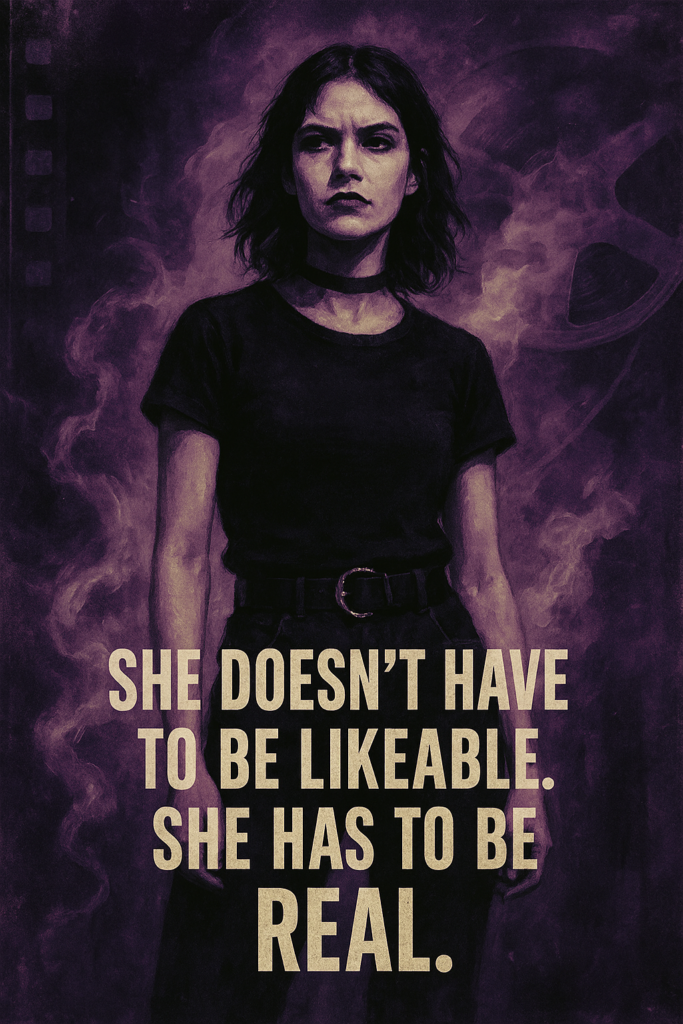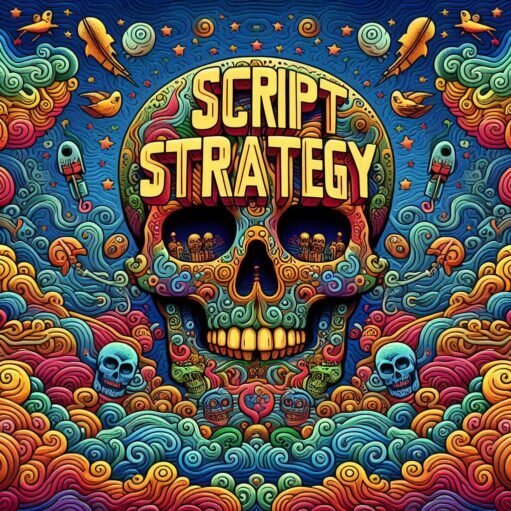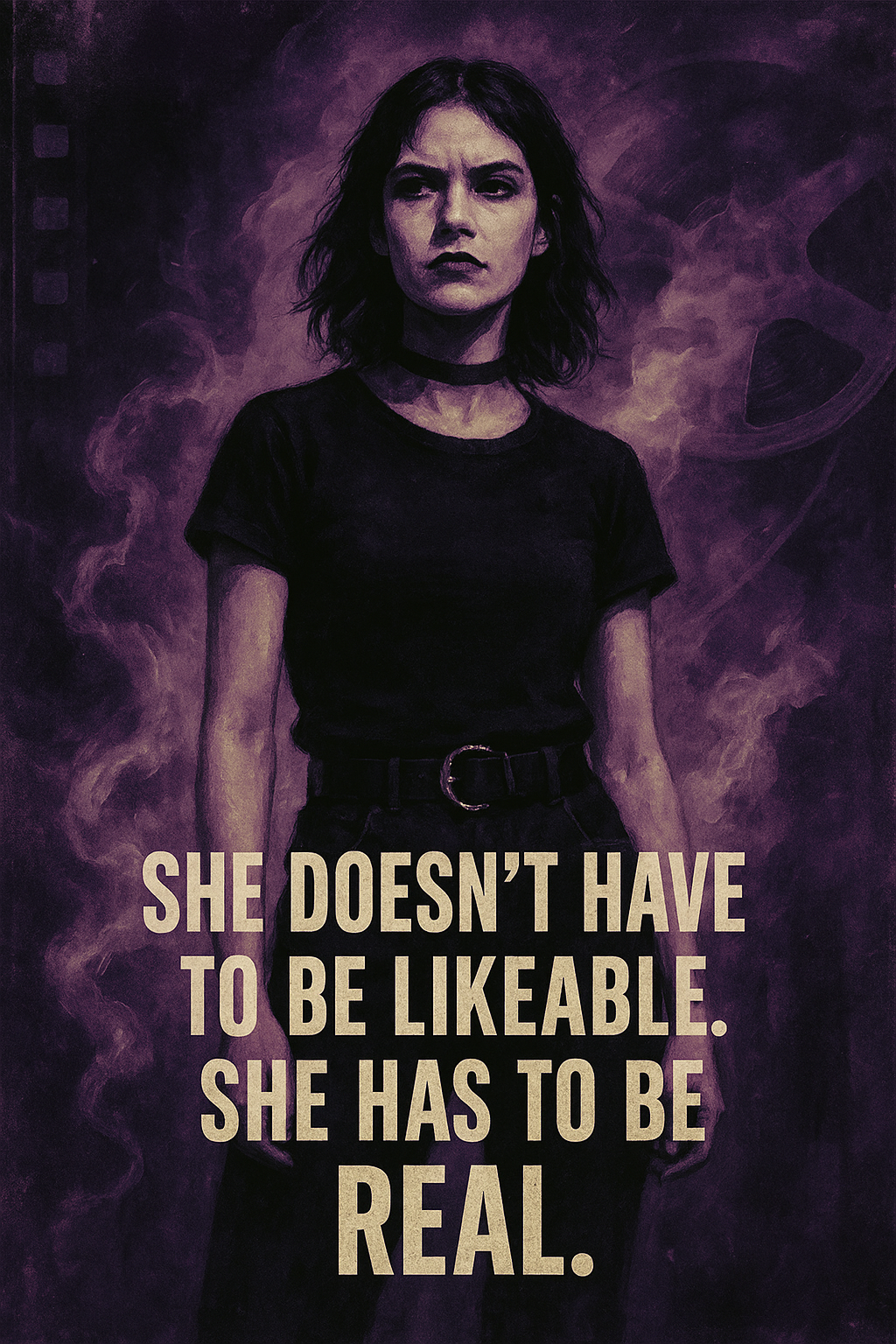(you can assume that links are affiliate links)
The Tyranny of Likeability When Writing Female Characters

Oh, man. Likeability sucks so much.
It’s too often used as a cudgel whenever someone can’t figure out anything intelligent to say about your script. That doesn’t mean they’re necessarily wrong–I mean if you actually wanted your character to be likeable–but that’s certainly not always the point.
Particularly if your character is a woman.
The question, if you’re writing a strong female character, is whether the pushback you’re getting is because of the above, something legit wrong about the character, or–too often–some fucked up cultural baggage.
That’s where we’re going to go now.
Men Can Get Away With It
Male protagonists, quite obviously, are allowed to be cruel, selfish, broken, or morally compromised—and, let’s face it, they are often celebrated for it. Don Draper lies and manipulates his way through Mad Men. Tony Soprano is a cold-blooded killer. Travis Bickle stews in his own violent delusions. Vito Corleone routinely has people murdered. Bob Crane is an unrepentant sexual deviant. These men are not just tolerated; they are mythologized.
Women, however, are rarely afforded that same mythological license.
Being human means mess, contradiction. There’s no reason that female characters must be filtered through some antiquated demand for charm, vulnerability, or redemption. Yet, too often, they are.
As film critic and author Anna Bogutskaya observes in Unlikeable Female Characters, “Behind unlikeability lies humanity, which is flawed by default and necessity.”
Our culture, by and large, denies that flawed humanity to women. In both studio and indie filmmaking, a strong female lead is often softened or “de-fanged” in the editing room—or, worse, in rewrites—under the guise of “relatability”: code for “nice.”
This is pervasive and systemic. As Bogutskaya notes, “[We] have been socialized to accept a narrative that limits women’s permission to fail or be flawed.” And if you’re a writer creating such a character you may face pressure to revise, dilute, or apologize for your protagonist’s abrasive traits.
The Problem With “Strong Female Characters”
“Strong female character” is one of the most paradoxical phrases in contemporary film. It conjures the image of a woman who kicks ass, yet doesn’t ruffle feathers. The woman who leads, but remains nurturing. The woman who suffers, but never becomes a total mess. The woman who outwits men, but is careful never to tread on their precious dangleberries.
There might–maybe–be room for stoic endurance in such women, but there sure as shit isn’t space for rage. Clearly that is unrealistic.
In fact, it makes one wonder whether the character is only “likeable” because she is never allowed to be real.
Filmmaker Stéphanie Joalland once told me: “Strong women are often perceived as being challenging and overbearing… when they act the same way as their male counterparts.” In other words: a woman who is confident, capable, ambitious, and unapologetic is at risk of being labeled “unlikeable”—even in fiction.
Humanity, not sweetness or softness, is crucial to any realistic character–regardless of her junk.
A Taxonomy of the “Unlikeable” Woman
In Unlikeable Female Characters, Bogutskaya lays out a framework for understanding how so-called “unlikeable” women have historically been portrayed in film and television.
Her Taxonomy of Unlikeability includes nine types: the Bitch, the Mean Girl, the Angry Woman, the Slut, the Crazy Woman, the Psycho, the Trainwreck, the Shrew, and the Weirdo.
Bogutskaya makes the point that these must not be thought of as archetypes in a normal sense; rather, they are categories used to dismiss female characters. Almost all of these categories fail to encapsulate the full humanity of a character.
Nevertheless, they often serve as boxes that female characters are expected to fit into. Feedback from what the Industry agrees to produce–that is, how what gets made influences even original writing, although literal (not figurative) script feedback might be similar–make writers inclined to feel they’re only permitted to use these boxes.
By contrast, it would seem weird–wouldn’t it?–to see Travis Bickle dismissed as a “psycho.” This despite the fact that by any objective measure he basically is a total fucking psycho.
But no, he’s “complicated.” Never “crazy.” But that’s the first thing many are inclined to say about a female character.
The Weirdo is perhaps the only figure in Bogutskaya’s taxonomy who escapes easy condemnation. From Lydia Deetz in Beetlejuice to Wednesday Addams to Harley Quinn, the Weirdo is not like the other girls—deliberately so. She is arch, idiosyncratic, rule-breaking, creative. She’s allowed to be angry, but only if it’s ironic. She may live by her own rules, but those rules had better allow for some fun–and style to boot.
Bogutskaya notes, crucially, that beneath the Weirdo’s abrasive exterior lies “a big heart… a non-judgmental nature that is welcoming to strangers.” She does not seek approval. And that, perhaps, is a woman’s true rebellion–at least as far as the current state of screenwriting goes.
Exercise 1: Define Her Moral Universe
A good place to begin when writing a complex–let’s face it, “unlikeable”–female protagonist is to define her internal code.
What does she value?
What will she fight for?
What lines will she never cross?
Make sure this doesn’t mean “redemption arc.” This in no way is about being punished for her flaws or rehabilitated by love.
Rather, treat the character as if she’s a real person with a real moral sense. Her ethics may be deviant, but they are deeply held. Look at Harley Quinn in Birds of Paradise or The Suicide Squad–I hate spandex movies as a rule, but these are two winners, not least because of Harley.
Exercise Prompt:
Write a short scene wherein your character does something “bad”—lies, betrays a friend, makes a cruel comment. However, according to her own logic, she is able to justify it.
What is she protecting?
What specifically is this logic?
Make it true for her, even if it doesn’t match normal people’s thinking.
Cultural Bias Is Not an Excuse for Bad Writing
It’s tempting to blame the audience when a female character is called “unlikeable.” And yes, a gendered double standard is very real.*
But that doesn’t let writers off the hook.
We owe female characters depth, contradiction, and agency. “Likeable” must not be a default; rather, these women must be believable.
Imagine if Shiv Roy had been made “likeable”: always fair, never one for a power grab, always told the truth, always let a man go first. She’d simply be forgettable. Instead, we remember Shiv because she was real. Because she was wrong sometimes. Often, even. She hurt people. She was herself, without apology.
Female protagonists aren’t trying hard to be besties over a brunch date. Write women like they’ve lived things. Survived things. Because women have.
*Except in the US, obviously. That’s why they got rid of DEI–never needed it in the first place. Amirite? (Just to avoid flak from irony-challenged do-gooder idiots, that is a joke.)
Exercise 2: Make Her Alienating
A character who’s accidentally misunderstood is silly. What is this, some shitty Netflix-filler high school rom-com?
A real character can often be deliberately alienating.
This doesn’t mean she can’t be sympathetic. It means she doesn’t need to constantly explain herself.
Look at Jenny (Karen Allen) in Starman. Her self-destructiveness and inconsistency make the character. They aren’t harming the film; they humanize the psychological whiplash of a woman having to deal with the sudden appearance of a stranger–who happens to reside in her dead husband’s body.
Exercise Prompt:
Write a monologue in which your character expresses contempt toward being understood by those around her.
Let her own her weirdness, anger, or refusal to fit in. Bonus points if it includes a line you cringe when you think about saying out loud.
C’mon, just do it; actors love that shit.
Characters That Actors Will Fight Over
Here’s the good news: actors—especially great ones—aren’t looking to play someone nice. They’re looking for something meaty. They want contradictions, reversals, moral ambiguity. They want to be memorable. They want to act.
Think of the iconic female characters actors still reference: Norma Desmond, Lisbeth Salander, Annie Wilkes, Miranda Priestly, Amy Dunne. None of these women are easy to like. But every one of them demands attention. They get inside you. They refuse to leave.
The goal is not to have the character be admired. It’s to have the character be unforgettable.
Exercise 3: Give Her a “Fuck You” Scene
Every great “unlikeable” female character ought to have a “fuck you” moment.
That is, something shocking, defiant, or self-serving that would scare away a lesser writer than you. This need not be literal. It could be a decision, a betrayal, a refusal to conform.
In any case, it must be her moment. A moment where she knows she’s burning a bridge and does it anyway.
Exercise Prompt:
Write a scene where your character knowingly sabotages her own reputation/relationships because she believes the tradeoff is worthwhile.
Let the character do something selfish, petty, or socially inappropriate–but it must be emotionally true to the character.
Let her do something selfish, petty, or wildly inappropriate—but emotionally true.
A Female Character Doesn’t Have to Be Likeable. She Has to Be Real.
In a culture where “unlikeable” is still code for “female and uncooperative,” your job as a writer is not to avoid the label. Your job is to earn it.
So go ahead. Make her tough. Make her cruel. Make her weird. Make her mean. Make her smart enough to scare people. And then—only then—make her human.
If people don’t like her, what the fuck does she care?
Further Exploration:
- Unlikeable Female Characters by Anna Bogutskaya
- Difficult Women by Roxane Gay
- King Kong Theory by Virginie Despentes
- Three Billboards Outside Ebbing, Missouri (film and screenplay)
- Gone Girl (film and novel)
- Shiva Baby (film)

